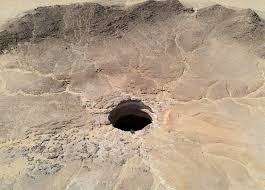A Gateway to the Unknown in the Arabian Desert of The Well of Barhout
Deep in Yemen’s remote Al-Mahra governorate, a gaping 30-meter-wide sinkhole known as the Well of Barhout has terrified locals for centuries. Unlike ordinary desert cavities, this perfectly circular abyss emits strange odors, inexplicable sounds, and an aura of dread so potent that even birds avoid flying over its opening. Bedouin tribes whisper that it’s the actual “Door to Hell” mentioned in Islamic eschatology—a prison for evil spirits that occasionally sends up wails of the damned. Modern geologists remain baffled by its unusual properties, including the complete absence of any bacterial life in its depths and mysterious temperature fluctuations that contradict normal geothermal patterns.
Ancient Legends of Cursed Depths
Long before Islam reached Arabia, the Well of Barhout featured prominently in Himyarite kingdom mythology as “Bab al-Arwah” (Gate of Souls). Ancient inscriptions near the site describe ritual sacrifices thrown into the hole to appease underground deities. One particularly chilling legend tells of a 6th-century sorcerer who attempted to harness the well’s power, only for his entire village to vanish overnight—a story that gained eerie credibility when archaeologists found an abandoned settlement with undisturbed household items just 3 kilometers away. The Quran’s mention of a “smokeless fire” beneath the earth (Surah Ar-Rahman 55:35) is often locally interpreted as referencing this very location.
The Well of Barhout: The Science Behind the Supernatural
Recent expeditions have revealed the well descends at least 112 meters into the earth, with its upper walls lined with strange, sponge-like mineral formations that absorb sound. What makes Barhout scientifically unique:
- A constant 98% humidity level despite the surrounding desert climate
- Unexplained magnetic anomalies near the opening
- Layers of hydrogen sulfide gas that may explain the “rotting flesh” odor
Most puzzling is the complete absence of the usual cave ecosystems—no bats, insects, or even microbes. When a 2021 Omani scientific team lowered sterile sampling equipment, it returned with water samples containing unidentified crystalline structures that dissolved upon exposure to sunlight.
Forbidden Exploration and Government Secrets
The Yemeni government long prohibited access to the well, fueling conspiracy theories. Declassified documents reveal that in 1989, Soviet geologists working in South Yemen attempted to explore the cavity using spelunking equipment, but aborted the mission after their radios malfunctioned and team members experienced shared hallucinations. More recently, a 2020 UAE-funded expedition captured thermal images showing unexplained heat signatures moving vertically along the walls at speeds impossible for any known animal. Local military personnel stationed nearby report an unofficial “no-fly zone” enforced not by law, but by pilots’ refusal to approach the area.

Strange Phenomena and Documented Oddities
Beyond legends, the Well of Barhout exhibits measurable anomalies:
- Compasses spin erratically within 50 meters of the rim
- Electronic devices consistently fail to record below 80 meters depth
- Seismographs detect constant ultra-low frequency vibrations
Most disturbingly, in 2013, a German documentary crew allegedly recorded a 17-second audio clip of what sounded like distant human screaming from inside the well—though experts later determined the sounds didn’t match any known animal or geological noise. The recording mysteriously corrupted before proper analysis could be completed.
Sacred Guardians and Tribal Protectors
The Mahri people have appointed “Hafiz al-Bab” (Guardians of the Gate) for generations—a hereditary position responsible for keeping people away from the well. These guardians preserve oral traditions warning that the well:
- Grows deeper during drought years
- “Exhales” cold winds on the hottest days
- Contains water that causes plants to grow abnormally fast but die within days
In 2017, one guardian made headlines by claiming the well’s water level rises predictively before regional conflicts—a pattern some analysts found correlated with six major Yemeni political events since 1962.
Modern Expeditions and Unanswered Questions
The first government-sanctioned descent occurred in 2021 by a joint Yemeni-Omani team. Their limited findings included:
- A previously unknown mineral coating the lower walls that glows faintly under UV light
- Ancient rope fragments dating to the Sabaean period (800 BC)
- Vertical shafts too perfectly cylindrical to be natural
Most intriguing was the discovery of an underground chamber partially flooded with black water that reflected light in unnatural patterns. The team abruptly terminated the mission when their oxygen monitors falsely indicated depletion despite full tanks.
The Well of Barhout: Between Geology and Mythology
While scientists theorize the well may be a rare “fossil void” from an ancient underground river, its full depth remains unexplored due to technical and… perhaps other challenges. The Well of Barhout stands as one of Earth’s last truly unexplained natural wonders—a place where measurable science intersects with centuries of consistent supernatural accounts. Whether a geological oddity or something more mysterious, this “Door to Hell” continues to guard its secrets fiercely, just as it has for millennia.
As Yemen gradually opens to international research, the well represents both an extraordinary scientific opportunity and a sobering reminder that some of Earth’s mysteries may resist explanation. For now, the morning sun still casts long shadows across its circular mouth, while somewhere in those lightless depths, water drips rhythmically against stones untouched by human hands—each drop echoing through a chamber that has kept its secrets for longer than recorded history.
Go to main page


